Search results for: 'bronze'
-
 Brooch from Roman Britain
Brooch from Roman BritainA rare mixture of cicada fibula and trumpet fibula, from the 2nd century. Found on the Isle of Wight.
Price: on request Anglo-Saxon gilt bow brooch
Anglo-Saxon gilt bow broochA find from the Isle of Wight from the Migration Period. Beautiful testimonial of the settlement of Britain by the Anglo-Saxons.
Price: on request Roman Hod Hill brooch
Roman Hod Hill broochMade around the year 100 and found on the Isle of Wight, after the Roman conquest of Britain.
Price: on request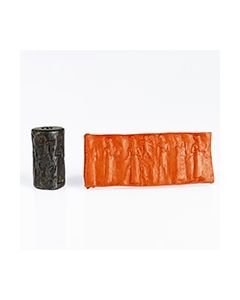 Rare cylinder seal with Old Babylonian and Old Assyrian engravings
Rare cylinder seal with Old Babylonian and Old Assyrian engravingsThis seal from Old Babylon has been reworked in Old Assyrian style, probably in Anatolia or Northern Syria. It tells a story of political and cultural diversity in the ancient Near East.
Price: on request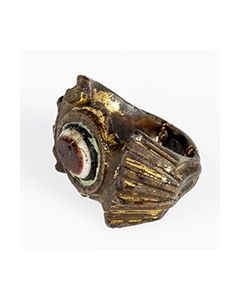 Roman finger ring with imitated agate
Roman finger ring with imitated agateMassive gold plated finger ring dating to the Late Roman Imperial period. The ring impresses with a particularly nice multi-layer glass gem in red, white and black.
Price: on request Early Villanovan Amphoriskos
Early Villanovan AmphoriskosImpressive impasto vessel with nice decorations. Including TL analysis report.
Price: on request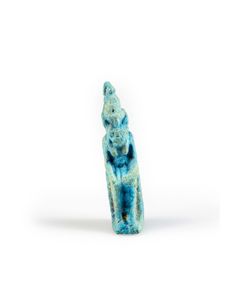 Egyptian faience figurine of the goddess Mut
Egyptian faience figurine of the goddess MutRare syncretic merging of the goddesses Mut and Sekhmet. The lion headed statuette is shown enthroned with the double crown of Upper and Lower Egypt.
Price: on request Eisenzeitliche, europäische Fibel
Eisenzeitliche, europäische FibelHervorragend erhaltene, keltische Bronzefibel aus der Eisenzeit, 6. bis 3. Jh. v. Chr. Früher Fibeltyp in schöner Erhaltung.
Price: on request Frühe, europäische Fibel
Frühe, europäische FibelHervorragend erhaltene, keltische Bronzefibel aus der Eisenzeit, 6. bis 3. Jh. v. Chr. Großartiges Beispiel für einen der frühesten Fibeltypen.
Price: on request Frühe, europäische Fibel
Frühe, europäische FibelVollständig erhaltene, keltische Bronzefibel aus der Eisenzeit, 6. bis 3. Jh. v. Chr. Großartiges Beispiel für einen der frühesten Fibeltypen.
Price: on request Rechteck-Fibel aus dem 2. bis 3. Jh.
Rechteck-Fibel aus dem 2. bis 3. Jh.Antike römische Brosche. Dekorierte Platte mit Resten von Email. Typ aus dem 2. bis 3. Jh. n. Chr., 20mm x 33mm.
Price: on request Gorgeous Roman Imperial fibula
Gorgeous Roman Imperial fibulaThe large bow is dominated by colourful enamel. It is a brooch type that developed during the 1st cent. AD in Central Europe.
Price: on request Thin butted axe head with finely polished surface
Thin butted axe head with finely polished surfaceDünnnackige Beilklinge der Trichterbecherkultur, Dolmenzeit bis Ganggrabzeit. Aus feinem, grauen Flint mit schönen Einschlüssen gearbeitet.
Price: on request Thin butted axe head made of fine grey flint
Thin butted axe head made of fine grey flintDünnnackige Beilklinge der Trichterbecherkultur, Dolmenzeit bis Ganggrabzeit. Aus wunderbarem grauen Flint mit feiner Politur.
Price: on request Neolithic thin butted axe head
Neolithic thin butted axe headDünnnackige Beilklinge der Trichterbecherkultur, Dolmenzeit bis Ganggrabzeit. Präzise aus schönen, grauen Flint gearbeitet.
Price: on request Rectangular axe head
Rectangular axe headDünnnackiger Beilkopf der Trichterbecherkultur, Dolmenzeit bis Ganggrabzeit. Sehr schön bearbeiteter grauer Flint.
Price: on request Thin butted axe head from the Funnel Beaker culture
Thin butted axe head from the Funnel Beaker cultureDünnnackige Beilklinge aus grauem Flint mit schönen rot-braunen Einschlüssen. Dolmenzeit bis Ganggrabzeit. Beeindruckend durch die Größe.
Price: on request Neolithic thick butted axe head
Neolithic thick butted axe headKlinge eines dünnblattigen Dicknackenbeils. Trapezförmiger Körper aus schönem grauen Flint mit kleinen Einschlüssen. Ganggrabzeit bis Dolchzeit.
Price: on request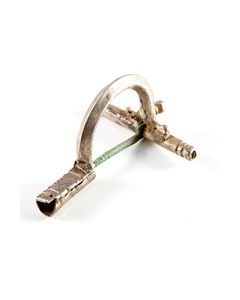 Römische Zwiebelknopf-Fibel aus Silber
Römische Zwiebelknopf-Fibel aus SilberBeliebter Fibeltyp des 3. und 4. Jh. n. Chr. Typischerweise von römischen Männern getragen. Der Träger dieser Fibel aus Silber hatte sicher eine gehobene soziale Stellung.
Price: on request Spitznackiges Beil der Älteren Trichterbecherkultur
Spitznackiges Beil der Älteren TrichterbecherkulturSpitzovales Längsprofil, grob bearbeitete Seiten, teilweise poliert. Typische für die Ältere Trichterbecherkultur, 4200 bis 3300 v. Chr.
Price: on request Trapezförmiger Beilkopf der Trichterbecherkultur
Trapezförmiger Beilkopf der TrichterbecherkulturFein polierte Breitseiten, unpolierte Schmalseiten. Schöner Flint mit heller Steinader an der Schneide. Gefunden um 1900 in Schackendorf, Schleswig-Holstein.
Price: on request Stone beaker of the Jiroft culture
Stone beaker of the Jiroft cultureHigh quality chlorite vessel from the Kerman province in Iran. From the 3rd millennium BC.
€3,610 Small Phrygian gold fibula
Small Phrygian gold fibulaThe richly decorated brooch is a wonderful miniature work of art. It is from the 8th or 7th century BC, when the empire of the Phrygans was at its height. The time when the legends around King Midas spawned.
€1,900 Anglo-Saxon bow brooch
Anglo-Saxon bow broochA find from the Isle of Wight from the Migration Period. Beautiful testimonial of the settlement of Britain by the Anglo-Saxons.
Price: on request Roman plate brooch
Roman plate broochBeautiful example with orange and turquoise enamel. A find from 2nd century Roman Britain.
Price: on request Anglo-Saxon bow brooch
Anglo-Saxon bow broochA find from the Isle of Wight from the Migration Period. Beautiful testimonial of the settlement of Britain by the Anglo-Saxons.
Price: on request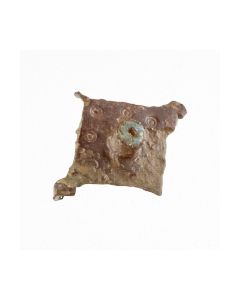 Roman fibula from the Richard Hattatt collection
Roman fibula from the Richard Hattatt collectionLozenge-shaped ancient roman fibula. The piece is published in the standard work "Iron Age and Roman Brooches". Found in Britain.
Price: on request Roman fibula from the Richard Hattatt collection
Roman fibula from the Richard Hattatt collectionLozenge-shaped ancient roman fibula. The piece is published in the standard work "Iron Age and Roman Brooches". Found in Norfolk, England.
Price: on request Gallo-Roman animal fibula
Gallo-Roman animal fibulaZoomorphe Fibel mit Wildtier als Motiv. Schmuckstück mit religiöser Symbolik, vergleichbar einem Kreuzanhänger bei heutigen Christen. Gefertigt im 1. bis 3. Jh. n. Chr. in Gallien.
Price: on request Nicely worked stone axe of the Corded Ware culture
Nicely worked stone axe of the Corded Ware cultureKlinge eines dünnblattigen Dicknackenbeils aus dem Endneolithikum mit sehr fein polierten Oberflächen. Gefunden um 1900 in Daldorf, Schleswig-Holstein.
Price: on request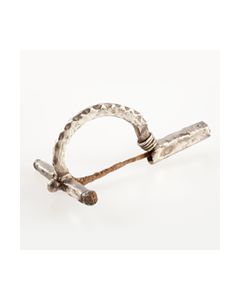 Silberne Armbrust-Fibel um 300 n. Chr.
Silberne Armbrust-Fibel um 300 n. Chr.Römische Fibel vom Typ der Armbrust-Fibeln. Massives Silber, 14,6g, 280 bis 320 n. Chr. Hervorragender Zustand.
Price: on request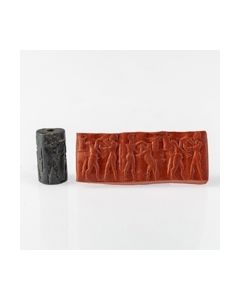 Cylinder seal from Old Assyrian trade outpost
Cylinder seal from Old Assyrian trade outpostWonderful example for the style of the Old Assyrian trade colonies in Anatolia. Well-known from Kültepe Level II. It shows a fighting scene between hero and bull man. Around 1900 BC.
Price: on request Old Assyrian cylinder seal from Anatolia
Old Assyrian cylinder seal from AnatoliaInteresting seal with religious scene. From an Old Assyrian trade outpost in Anatolia. It shows a god on a throne with goat feet.
Price: on request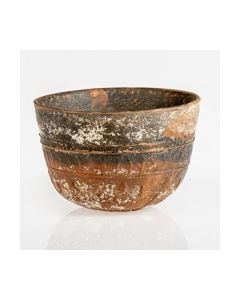 Megarian bowl with rich floral decoration
Megarian bowl with rich floral decorationPerfectly preserved and finely worked piece from a German collection in which it was acquired in the early 1970s.
Price: on request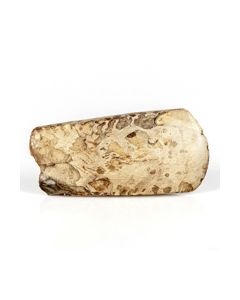 Neolithic thin butted axe head
Neolithic thin butted axe headAxe from the Early Neolithic is made of beautiful reddish brown flint with inclusions. Found in Northern Germany.
Price: on request Roman discus fibula with color glass paste
Roman discus fibula with color glass pasteSpannende Fibel mit Sterndekor und Glaspaste. Eine Weiterentwicklung keltischen Kunsthandwerks in der Zeit römischer Herrschaft. Gut dokumentierter Typ aus dem 2. Jh. v. Chr. mit Verbreitung in weiten Teilen Europas.
Price: on request

